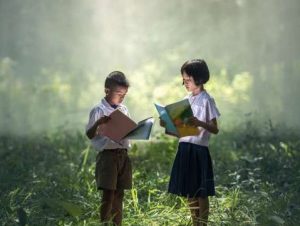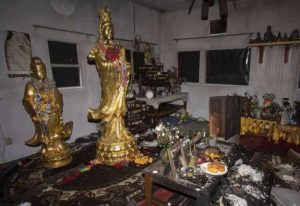
The Wallach Art Gallery, on the campus of Columbia University in New York City, is running an exhibition titled “What is the Use of Buddhist Art?” The exhibition, which began on 4 December 2021 and runs until 12 March, is intended to display the objects in their ritual contexts, showing both their production and use. The display is thus set apart from most art gallery and museum exhibitions, which focus only on the aesthetic dimensions of the exhibits.
“What is the Use of Buddhist Art?” is curated by D. Max Moerman, professor of Asian and Middle Eastern cultures at Barnard College. According to Moerman: “This exhibition is an opportunity to appreciate Buddhist visual and material culture in their contexts of practice and use: in rites of consecration and offering, visualization and protection, healing and fertility, and death and memorialization.” (Columbia University)
The exhibition website highlights the example of the “Votive Stele,” dedicated by Monk Zhilang and dated to 548 CE in Eastern Wei dynasty China. The piece includes an inscription that identifies and celebrates the purpose of creating Buddhist objects and images. The inscription reads: “We build stupas to mark our devotion, and we create image to express our dedication to the order.” (Columbia University)
Holland Cotter, co-chief art critic of The New York Times, offered a glowing review of the exhibition. In it, Cotter reminisced about a trip to Japan in 1983, where he first experienced Buddhist practitioners interacting with works on display at the Tokyo National Museum: “As I was lingering over a glorious ninth-century wood sculpture of a Miroku, the Buddha of the Future, a visitor near me clapped her hands quickly, and sharply, twice, something (I would learn) that visitors to temples and shrines do to honor a deity.” (The New York Times)
Cotter continued: “Later, in a different gallery, I noted that in front of another Buddhist figure the museum had placed a fresh lotus floating in a bowl of clear water. Through two gestures, one personal, the other institutional, the functional nature of religious images was made clear.” (The New York Times)
In describing the exhibition at Wallach, Cotter suggested that a similar experience is evoked:
Much of what’s in the show is the opposite of ostentatious or monumental. A copper and turquoise amulet box from Tibet, designed to hold a protective image or relic, is small enough to be kept in a purse or worn on a belt. In some cases, the power source of an object is permanently hidden, as in the case of a small pagoda-shaped wood stupa, one of millions distributed by an eighth-century Japanese empress to atone for the death of enemies killed under her watch. About the size of a chess piece, each stupa contains a printed incantation sealed inside, all the more potent for not being seen.
(The New York Times)
The exhibition features many objects that are on public display for the first time. The collection, much of it having been acquired over the span of nearly two centuries, has largely been donated by Columbia University alumni and faculty. Support for the “What is the Use of Buddhist Art?” exhibition comes from Frances Hsinyi Wu and Paul Pao-heng Yin, as well as the university’s Center for Buddhism and East Asian Religion.
Two talks have been scheduled to help visitors learn more about the art. One, which took place on 3 February, featured D. Max Moerman on the topic of consecration, incantation, and merit-making as three ways that the objects were used. A second talk, scheduled for 10 February at 6.30 pm EST (11.30 pm UTC), will be given by Michelle C. Wang, associate professor in the department of Art and Art History at Georgetown University. Dr. Want is the author of Maṇḍalas in the Making: The Visual Culture of Esoteric Buddhism at Dunhuang (Brill, 2018). Registration for her talk is available here.
Read more
What Is The Use Of Buddhist Art? (Columbia University)
What Museums Don’t Reveal About Religious Art (The New York Times)
Related news reports from BDG
New York’s Rubin Museum Offers an Immersion into Buddhist Wisdom and Practice
Brooklyn Museum to Unveil a New Gallery Devoted to Buddhist Art
Afghan Museums Fear for Ancient Buddhist Artifacts amid Taliban Takeover
National Museum of Korea Reopens with Extensive Exhibitions, Including Buddhist Treasures
British Museum to Showcase Tibetan Tantric Implements
New Museum Reveals Buddhist Mysteries of Korea’s Baekje Kingdom















